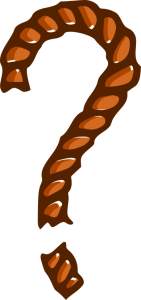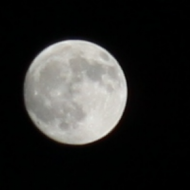
The Rope of Dreams – Polynomial
Imagine you are given a length of rope that is 120 meters long, and told that you can go to any place on Earth and whatever you enclose with the rope – is yours to keep, or do with whatever you wish. You can enclose only a single area, a single time, and then must return the rope. What would you do? You may not think of a Polynomial of the Second Order – a Quadratic Equation, but you probably should.
What would you do?
Say a big “Thanks”, take the rope, and start pondering the options. A likely plan is to think of where on Earth you want to go (a tropical island, a bustling city, a countryside retreat, maybe even Fort Knox – it’s your choice), and while en route to your destination figure out how to maximize the area the 120 meter rope can enclose. I’ll leave the destination to your own imagination (you can post in the Comments section below) and turn our attention for now to maximizing the area the rope can enclose once you get there. Did someone say Polynomial!
How long is a piece of string, or 120 meters of rope?
A likely first question you might have is to get an idea of just how long 120 meters is, so some reference examples might help, note that ‘m’ is short for ‘meter’. A soccer pitch is between 90m and 120m in length; A rugby pitch is 100m – the same as the 100m sprint in Athletics (Usain Bolt, Carl Lewis etc.); An American football pitch is 110m long; A CLG/GAA (Cumann Lúthchleas Gael / Gaelic Athletic Association) pitch is between 130m – 145m in length. For petrol heads, 120m is about 24 Nascars end-to-end, or 21 Formula1 cars end-to-end – that’s almost the entire grid – are you heading to Monaco with your rope?
Triangles and Rectangles and Squares, Oh My!
A second question might be what shape to use, that is a great question and goes to the heart of this blog post. You might think of a triangle like the ancient Egyptians; or a rectangle shape like so many sports pitches and courts; an oval shape like running and race tracks; or a square shape like many public Parks. Or maybe you didn’t think about shape at all, maybe you thought shape doesn’t matter; but shape matters a whole lot and we’re about to find out why.
Let’s try a Triangle – the Egyptian Pyramids stood the test of time reasonably well
So a triangle could be a good shape to try, and let’s make it a long triangle because it seems logical that the longer it is the more area it will have. Let’s say we go with a triangle with sides of length 50m, 50m, and a base of 20m – that totals 120m. This type of triangle, with two sides of equal length is called an isosceles triangle. Now lets calculate the area of the triangle. using the formula below we get an area of \(490m^2\). That seems decent, for 120m length of rope we can cover an area of 490 sq.m.
For a Triangle: \( Area = \frac {base \cdot height} {2} \)
Herons Formula: \( Area = \sqrt {p(p-a)(p-b)(p-c)}\)
where p is half the perimeter i.e. \(p = \frac {a+b+c}{2}\)
Now let’s try another configuration of triangle, one that is more symmetric, in fact an equilateral triangle i.e. a triangle with 3 sides of equal length. The equilateral triangle will have sides of 40m, 40m, and 40m – all equal, and totalling 120m. Using Herons Formula above we see that we now have an area of \(693m^2\), that’s over 200 sq.m. more than the previous triangle. With a slight change in how we used our rope we’ve bagged ourselves a considerable area with an equilateral triangle of \(693m^2\).
Q.) What do you call a broken Square? A.) A Rectangle.
Rectangle – Wrecked angle, broken square, get it. Heheheh. Ok, so if changing the shape of a triangle can bag us a bigger area, what about roping a rectangle! Once again we’ll go for a longer length and shorter width in the hope the longer dimension pays dividends. Let’s go with a rectangle of sides 50m and width 10m, that’s a total perimeter of 120m (50+10+50+10). This rectangle gives us an area of \(500m^2\). Hmm, that’s a bit better than our original isosceles triangle (490 sq.m.) but a lot less than our equilateral triangle (693 sqm.).
For a Rectangle: \( Area = length \cdot width \)
Now let’s try the same thing we did with the triangles i.e. go for a more symmetric shape, you can’t get a more symmetric rectangle than – a square. That’s right, a square is just a special case of a rectangle where the length and width are equal. A square will have 4 sides of 30m each, totaling 120m and using all our rope. The area of this square will be 30 times 30 i.e. \(900m^2\). That’s more like it, once again a reconfiguration of our shape has yielded a much greater area with a square yielding \(900m^2\).
Pentagons and Hexagons and Heptagons, Oh My!
Applying the lessons we learned from Triangles and Rectangles, it would seem that the more symmetric the shape the greater the area for a given circumference. So what shape is the most symmetric of all? Triangles, Squares, Pentagons, Hexagons, Heptagons, Octagons, and so on. But where does it end, what is the most sided shape you ca make?
The Circle. Were the ancient Irish right 5000 years ago – 1000 years before the Egyptian pyramids?
Is the ultimate shape the humble Circle, as used in the World Heritage Site Brú na Bóinne in Ireland over 5200 years ago in the prehistoric passage tombs of Newgrange, Nowth and Dowth? Let us see. The perimeter i.e. circumference of the circle we can describe is 120 meters long, using the equations below we can determine the radius of the circle will be \( \frac {60} {\pi} \), we can use that to determine the area of the circle which is \(1146m^2\). Winner! Optimizing out shape by using a circle has yielded us a maximum area to enclose with our rope of \(1146m^2\).
For a Circle: \( Area = \pi r^2 = \pi {( \frac{d}{2} )}^2 \), and \( Perimeter = \pi d \)
Given circumference, C, \( Area = \frac {C^2} {4\pi} \)
RESULTS
Remember that all of these areas were obtained with the same 120 meter long rope, no magic, only mathematics!
\(490m^2\) – Isosceles triangle.
\(693m^2\) – Equilateral triangle.
\(500m^2\) – Long Rectangle.
\(900m^2\) – Square.
\(1146m^2\) – Circle.
Polynomial! Where is the link with Polynomial Equations and the Quadratic?
I’m glad you asked. This all started when I was looking at numbers on a number line and squaring them and seeing how the values changed. Then I wondered, what is the difference between squaring a number (i.e. multiplying a number by itself); and multiplying the number to the left by the number on the right. So for example if I take the number 6, squaring it gives 36 (i.e. 6 * 6). Multiplying the number to the left by the number on the right is 5 * 7 = 35. 35 differs from 36 by 1. Interesting.
And what if I take the number 8, squaring gives 64; multiplying 7 * 9 = 63, once again this is one less. Interesting! Then I wondered if this relationship held for all numbers. Now multiplying an infinite amount of numbers is too much work, and that’s why we love Algebra because it saves us from all that extra work.
Let me call the number I pick, x. So the number to the left of x is one less i.e. x-1, and the number to the right of x is one more i.e. x+1. The examples above showed that:
My test cases showed: \( x^2 = (x-1)(x+1) + 1 \)
Multiplying this out: \( x^2 = x^2 + x -x -1 +1 \)
Simplifying: \( x^2 = x^2 \)
Q.E.D.
What if you move two places rather than one?
Next I wondered if there was a relationship between moving two spaces left and two spaces right. Taking 6 * 6 = 36, while 4 * 8 = 32; so a difference of 4. Interesting. Taking 8 * 8 = 64, while 6 * 10 = 60; again it is 4 less. Note that 4 is 2 squared i.e. 2 * 2 = 4.
What if you move three places rather than one?
Then I wondered about the relationship with moving 3 places. Since moving one space left a deficit of 1, moving 2 spaces left a deficit of 4, would moving 3 spaces leave a deficit of 9; or would it be 8? Let us see. Taking 6 * 6 = 36, while 3 * 9 = 27, so a deficit of 9. Interesting. Taking 8 * 8 = 64, while 5 * 11 = 55, again a deficit of 9. Note that 9 is 3 squared i.e. 3 * 3 = 9.
Generalizing using Algebra for Polynomials of the Second Order
Once again, taking x as the initial number, and n as the number of places to move to the left and right, we can see the above results give us the generality:
\(\boxed{ x^2 = (x-n)(x+n) + n^2 }\)
Once again, we should prove the proposed equation.
Starting with \({ x^2 = (x-n)(x+n) + n^2 }\)
Multiplying out \({ x^2 = x^2 +nx -nx -n^2 +n^2 }\)
Simplifying: \( x^2 = x^2 \)
Q.E.D.
You can try the formula with your own values, please comment below if your calculations agree or disagree – and you can provide numbers used, calculations and results. You can confine your calculations to Integers i.e. positive and negative whole numbers including 0.
Does the Equation explain the choice of Shape?
Great question, and the answer is Yes. The equation tells us algebraically and in a more general and proven way, what we found out empirically by choosing different types of shape. The ideal scenario is to choose a value of n = 0 i.e. not to wander away from the square condition. The further you wander, i.e. the greater n, then the greater \(n^2\) will become. If you move 2, the loss is the square (\(n^2\)) i.e. 4, if you move 3 the loss is 9, if you move 4 the loss is 16, if you move 5, the loss is 25 and so on. This is why the isosceles triangle of 50-50-20 was much worse than the equilateral triangle of 40-40-40. It is also why the rectangle of 50-10-50-10 was much worse than the square of 30-30-30-30.
So why was the Circle the best Shape?
Another great question. If you look carefully at the boxed equation above you may notice that it is very similar to the equation of a circle, and also very similar to Pythagoras Theorem. But really it boils down to symmetry, the way to get a maximum area with a given perimeter/circumference is to use a circle because it satisfies these equations and gives a maximum value. Corners are inefficient, curves are efficient.

Be mindful the opposite is true when it comes to packing and stacking i.e. corners are efficient and curves are inefficient. The Hexagon is a nice compromise between minimizing perimeter, maximizing area, and maximizing stacking and packing. Somehow bees seem to know this and build their nests accordingly.
Our equation: \(\boxed{ x^2 = (x-n)(x+n) + n^2 }\)
Eqn. of a Circle: \( r^2 = (x-h)^2 + (y-k)^2 \)
Pythagoras Theorem: \( c^2 = a^2 + b^2 \)
Conclusion
Take that Rope of Dreams, decide where you want to go, and if you want to maximize the area you cover – choose a circle. If you liked this post you will probably like the posts on the Monty Hall Problem – Can You Solve This Maths Puzzle? Enjoy!
UPDATE: You’ll definitely like the follow-up post to this which takes things to another Dimension (there’s even mention of the BORG), The Rope of Dreams Recut: Polynomials of the Third Order – Cubic Equations. Triple enjoy!
